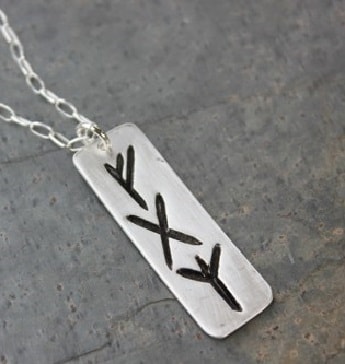What are Viking Runes
Viking runes are ancient Norse symbols used for writing, telling fortunes, protection, and casting spells. Each symbol is not only a character in the ancient Scandinavian alphabet but is also believed to have magical or supernatural powers. The medieval Norse people inscribed these symbols on all kinds of objects such as great monuments, common household items, tombstones, and Runestones. Stone rune sets were used to tell fortunes. Viking warriors would inscribe these symbols on there swords and shields for protection and to bring misery to the enemy.Click here for a great selection of Amazon.com Rune jewelry.
Who Created Runes
The Vikings believed runes were created when their chief god Odin speared himself to the cosmic world tree, Yggdrasil in hopes of receiving occult knowledge. For nine nights he hung on the tree and the mysteries of the runes were revealed to him. He then passed this knowledge onto his people. This gift from Odin was greatly treasured by the Nordic people. Runes were actually created by the Germanic people who occupied northern Europe sometime around 100 to 200 A.D. It is believed that these Germanic people adopted either the Etruscan or Latin alphabet in developing runes. The Vikings adopted these symbols for their own use. The name of the runic alphabet is Futhark. This name is derived from the first six sounds (f, u, th, a, r, k) in the alphabet.Rune Master
The Vikings took the magical powers of runes very seriously. One Norse poet wrote about the Viking runes stating "Let no man carve runes to cast a spell, save first he learns to read them well." Due to the perceived supernatural powers of runes and the potentially dangerous consequences of not fully understanding their meanings, rune masters were called upon to interpret them. These rune masters were specialists and trained in understanding and using runes to tell fortunes and to cast spells. Rune masters held a high position in the Viking world. There are many stories of their great feats. For example one ancient story exists of a women becoming seriously ill after the incorrect runes were carved on a whale bone and hung over her head. A rune master was summoned who corrects the runes which lead to the women’s recovery. There is another tale of a rune master putting protective runes on his drinking horn. The drinking horn breaks in two when a rival tries to kill him by pouring poison into it. The rune masters knowledge of runes saved his life.
Rune masters were also known for casting rune stones to tell fortunes. There were several ways to cast runes. One way was to put the rune stones in a bag, shake the bag, and then cast them on the ground. The rune stones that landed face up were used to tell the fortune.
Viking runes did not disappear with the coming of widespread Christianity in northern Europe. They can be seen side-by-side with Christian symbols on gravestones, coffins, and monuments. Runes were still in wide spread use up to the 17th century when the church banned their use. They did this in an attempt to eliminate paganism, superstition, and magic. This did not eliminate the use of runes but was successful in eliminating their widespread use.
